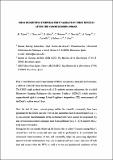Por favor, use este identificador para citar o enlazar a este item:
http://hdl.handle.net/10261/75444COMPARTIR / EXPORTAR:
 SHARE
BASE SHARE
BASE
|
|
| Visualizar otros formatos: MARC | Dublin Core | RDF | ORE | MODS | METS | DIDL | DATACITE | |

| Título: | SMOS' brightness temperatures validation: First results after the commissioning phase |
Autor: | Talone, Marco CSIC ORCID ; Gourrion, Jérôme CSIC; Sabia, Roberto CSIC; Gabarró, Carolina CSIC ORCID ; González Gambau, Verónica ; Camps, Adriano CSIC ORCID; Monerris, A. CSIC ORCID; Font, Jordi CSIC ORCID CVN; Corbella, Ignasi | Fecha de publicación: | 2010 | Editor: | Institute of Electrical and Electronics Engineers | Citación: | 2010 IEEE International Geoscience & Remote Sensing Symposium Proceedings: 4306-4309 (2010) | Resumen: | Soil Moisture and Ocean Salinity (SMOS) mission is the second of European Space Agency's (ESA) Living Planet Programme Earth Explorer Opportunity Missions. SMOS's objective is to provide global and frequent Soil Moisture and Sea Surface Salinity maps. The single payload embarked on SMOS is the Microwave Imaging Radiometer by Aperture Synthesis (MIRAS), it is a 2D interferometric radiometer operating at the protected L-band with a nominal frequency of 1413.5 MHz. Since SMOS is the first 2D interferometric radiometers put in orbit so far, the characterization of the interferometrically measured brightness temperatures is an attractive topic for the scientific community. This study is focused on the estimation of the systematic antenna-based pattern in the measured brightness temperatures. Two improvements to the currently used method (Ocean Target Transformation) are proposed: 1) The elimination of the use of any forward model in the estimation of the bias. 2) The homogenization of the geophysical parameters distribution within the SMOS Field of View. Ocean Target Transformation is introduced in section 2, the proposed model-free methodology is described in section 3, while the effect of homogenizing the geophysical parameters distribution inside the FOV is assessed in section 4. The main conclusions are presented in section 5 | Descripción: | 2010 IEEE International Geoscience & Remote Sensing Symposium (IGARSS 2010), July 25-30 2010, Honolulu, Hawaii, U.S.A. | Versión del editor: | https://doi.org/10.1109/IGARSS.2010.5654257 | URI: | http://hdl.handle.net/10261/75444 | DOI: | 10.1109/IGARSS.2010.5654257 | Identificadores: | isbn: 978-1-4244-9566-5 e-issn: 2153-7003 |
| Aparece en las colecciones: | (UTM) Libros y partes de libros (ICM) Libros y partes de libros |
Ficheros en este ítem:
| Fichero | Descripción | Tamaño | Formato | |
|---|---|---|---|---|
| Talone_et_al_2010_preprint.pdf | 82,44 kB | Adobe PDF |  Visualizar/Abrir |
CORE Recommender
Page view(s)
312
checked on 19-may-2024
Download(s)
285
checked on 19-may-2024
Google ScholarTM
Check
Altmetric
Altmetric
NOTA: Los ítems de Digital.CSIC están protegidos por copyright, con todos los derechos reservados, a menos que se indique lo contrario.
